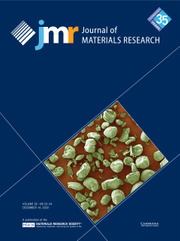Article contents
Auger electron spectroscopy and x-ray photoelectron spectroscopy analysis of angle of incidence effects of ion beam nitridation of GaAs
Published online by Cambridge University Press: 31 January 2011
Extract
Ion beam nitridation (IBN) of GaAs at room temperature was studied as a function of N2+ ion incident angle at ion energy of 10 keV. The ion beam bombardment surface area of GaAs was characterized in situ by both Auger electron spectroscopy (AES) and small spot-size x-ray photoelectron spectroscopy (XPS). Thin GaN reaction layers are formed at all N2+ ion incident angles, whereas the formation of As–N bonds has not been found. However, the degree of nitridation of Ga decreases with increasing incident angle. The observed angular dependence of the N incorporation can be explained in terms of sputtering yield, indicating that the growth kinetics can be described as a dynamic process comprising the accumulation of N and sputter removal of the surface layer. N2+ ion bombardment causes the depletion of As from the surface region because of the preferential sputtering of As from GaAs. The preferential sputtering of As reduces with increasing N2+ ion incident angle. The angular dependent behavior of preferential sputtering of As by 10 keV N2+ ions can be attributed to the angular dependence of GaN surface layer formation.
Information
- Type
- Articles
- Information
- Copyright
- Copyright © Materials Research Society 1998
References
- 10
- Cited by

